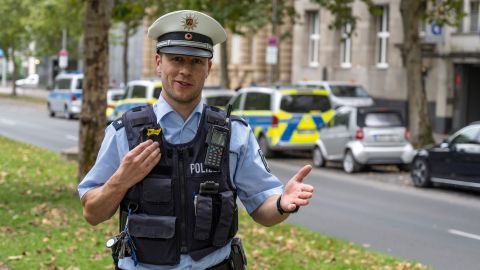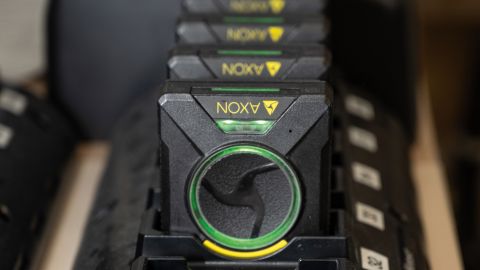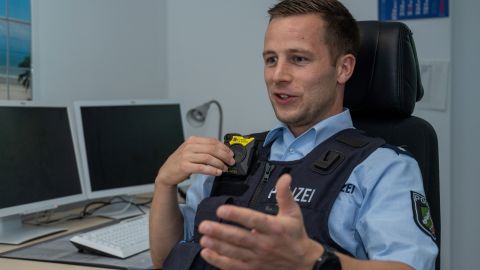It's a sunny Wednesday afternoon. Fabian zur Linden's late shift starts in just over two hours. "Today I'm supporting the head of our shift," says the 28-year-old police inspector. He has been working at Düsseldorf Police Headquarters since 2014. After working in property protection and in the central police station's priority service, he is now on duty as a security guard at the Stadtmitte police station.
Before starting work, he puts on his equipment for the upcoming shift in the patrol car: Uniform with protective vest, system belt with pistol. Plus the electronic helpers: radio, official smartphone and bodycam. "Not everyone has a bodycam, but they are stored centrally at the police station," explains zur Linden. The bodycam is therefore issued to every officer at the start of their shift and is not personally assigned equipment.
What kind of camera is that?
The camera is almost square at seven by nine centimeters and weighs 142 grams. So it's pretty light. "I hardly notice it when I'm on duty," explains zur Linden. The small camera has an eye-catching button in the center of the front, with the actual optics on the edge. Black lettering on a yellow background indicates the recording device. The bodycam not only records video in HD quality, but is also equipped with a microphone. This allows operations to be played back in image and sound in the event of a recording.
Now, however, the bodycam still needs to be attached to the uniform. There are various options. Fabian zur Linden describes which option he prefers: "It's worked really well since the external carrying case was introduced." This is a multifunctional vest that is worn over the actual uniform - with an integrated carrying device for the bodycam. "The device is simply clipped in, just like a radio."
The cameras can withstand frost and heat up to 50 °C and humidity. They are stable and can withstand a drop from a height of 1.80 meters. The lithium-ion batteries are designed to operate for around twelve hours and are therefore normally sufficient for an entire shift.
From 2017 to 2019, five of the 47 district police authorities initially tested the bodycam. The pilot project of the LZPD NRW (State Office for Central Police Services NRW) was scientifically monitored and was a success. "I was involved in the introduction at the station right from the start," says Fabian zur Linden. "The most significant improvement is the holder. In the beginning, there was still a magnetic holder, which was not practical. Since the introduction of the external carrying case, we have been wearing the bodycam firmly and securely on our bodies."
In the meantime, the body-worn recording device, as the bodycam is formally known, has become a tried-and-tested standard piece of equipment for security services across the country. It is intended to deter potential attackers and perpetrators of violence, i.e. to prevent danger and have a de-escalating effect. The bodycams also enable evidence-proof documentation of criminal acts through video recording. The new deployment tool thus offers a solution for recording, storing and analyzing important video and audio evidence in day-to-day operations. This includes an interface for data transmission.
"In our station, the bodycams are charged at a docking station. In addition to the charging function, it also has a direct network connection so that the data is immediately and automatically transferred to the security officer's computer and saved. This works very well in practice and makes work easier," explains zur Linden.
The camera support has long since proven its worth in day-to-day operations, he reports: "The bodycam is often used in particular for rioters, brawls or operations involving large groups of people in Düsseldorf's old town." The bodycam is then usually used on an ad hoc basis. "Unfortunately, people sometimes forget to switch it on in a hurry, so we've been annoyed afterwards that we didn't have the footage available. It all has to settle in."
When is the use of the bodycam permitted?
Switching on the camera is subject to certain legal requirements. These were created in 2016 with the introduction of Section 15c of the NRW Police Act. "Data collection through the use of recording devices worn close to the body" is the name of this paragraph. The authorization basis regulates in detail who may make recordings, for what purpose and in what situation. Special procedural regulations are also specified, e.g. for use within homes, deletion periods and exploitation rights.
The use of bodycams in homes is only permitted if facts justify the assumption that this is necessary to protect against an urgent threat to life or limb. In such cases - except in cases of imminent danger - the decision lies with the police officer in charge of the operation. Any activation of the recording device must also be communicated to the persons concerned, unless there is imminent danger.
But how do you train the many security officers for a new device? Or can the bodycam be operated intuitively?
"Yes, it is," says zur Linden. "I was trained as part of a service training course in which our multiplier presented the most important functions and operating options in addition to the legal requirements. The Bodycam is very easy to use and poses no problem for my colleagues."
The LAFP NRW (State Office for Training, Further Education and Personnel Affairs of the NRW Police) is responsible for training the thousands of users together with the local authorities. The multipliers were prepared in 30 seminars in Selm-Bork. They are supported by a virtual course room. The LAFP NRW provides videos, presentations and background information - online and therefore accessible anytime and anywhere.
First field reports are available
The delivery of the bodycams to the security service of the NRW police was completed on June 19, 2020. And the first field reports are already available. For example, the bodycam is always initially used for self-protection, i.e. to avert danger. Depending on how the situation develops, the recordings are then also used to preserve evidence in criminal proceedings.
In many operations, the bodycam is also used to document legally and tactically unobjectionable interventions. Simply having the bodycam with you or switching it on has a de-escalating effect. However, experience has shown that the effect of the bodycam is limited for people who are under the influence of alcohol or narcotics or have mental impairments.
To zur Linden, this is also confirmed: "For me, the bodycam is a considerable benefit, especially for evidence-proof prosecution, in order to document the police measures taken." For example, some authorities report on specific operations that have been influenced by the use of the bodycam.
One authority in the Ruhr area, for example, was involved in a disturbance operation that led to a tumultuous confrontation with around 20 people in a backyard. The bodycams carried by several officers recorded the acts of resistance. The main suspect was also ordered to be remanded in custody for the acts listed and recorded. Another police officer from the Ruhr area also reported on the preventative effect of the bodycam. After pointing out to a troublemaker that the bodycam was switched on, he had fewer problems in the further handling of the operation. Zur Linden has also had different experiences during operations: "There are people who react very sensitively to the bodycam. But there are also people who quickly calm down."




